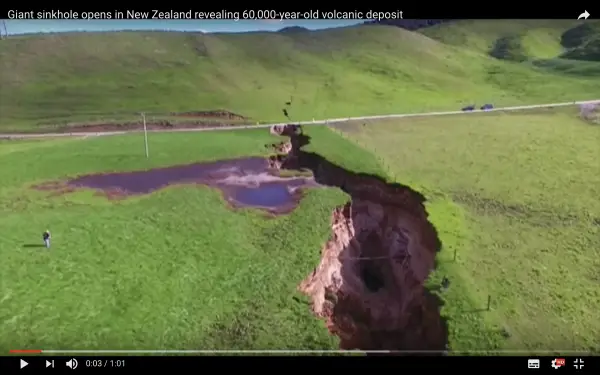Biggest Sinkhole In New Zealand Uncovers 60,000-Year-Old Volcanic Crater

Many people bicycle in the morning. Not only is it a great way to exercise, it is an eco-friendly way to commute. Last Sunday, however, a bicycle ride nearly turned into a deadly affair for Gabriel Lafalla. This is because, the New Zealand worker was unknowingly cycling along a gargunatan sinkhole. The huge crack was later revealed to be a 60,000-year-old volcanic crater.
The farm assistant was the first to discover the fissure which opened up on the dairy farm where he works. The phenomena, which is located roughly 16 km outside of Rotorua, measures over 150 meters long and 20 meters wide. “I could have died. I touched myself [the sign of the cross] and said to myself, ‘I’m alive’.” said Lafalla, remarking on the close call. “It was good timing, and I always keep to the left of the road.”
According to Stuff, the sinkhole resulted from torrential rains. Over the weekend, Rotorua recorded its highest ever hourly rainfall rate with 51.8 mm falling in a one-hour period. To put that into perspective, that’s the approximate amount Rotorua receives in one month. The flooding was so bad, Rotorua Mayor Steve Chadwick declared a state of emergency later that day.
The farm’s manager, Colin Termain, was just as astounded by the sinkhole as Lafalla. He told ABC News: “It wasn’t until I came down in daylight that I actually saw just how big it was. We’ll keep it fenced off as it is to keep stock out, although stock aren’t stupid, they’re not going to walk into a hole, they can spot danger.”
As IFLScience reports, geologists believe the hole has been slowly forming over the last century, with rainfall slowly eroding the underlying sediment. There are around seven fault lines that run across the region. As water percolates through the soil, it follows these faults and takes the soft limestone with it.
Scientists are eager to study the sinkhole, as it offers a glimpse of the underlying volcanic rock of a 60,000-year-old crater. The task won’t be an easy one, though, as there is at least 10 meters (33 feet) of sediment from when the crater filled with water and transformed into a lake. With more rain, the hole will continue to open up. Then, researchers will have their field day.
What are your thoughts? Please comment below and share this news!
Leave Comment: